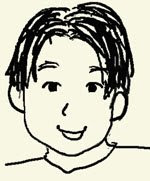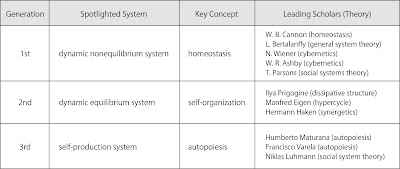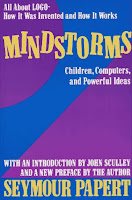In this post, I shall explain the autopoietic systems theory. Note that the following explanation based on my interpretation of the formulation by Niklas Luhmann, who generalized the concept from biological systems theory to general systems theory for building a new social system theory.
Autopoiesis means self-production, and autopoietic system means the system that produce itself. The concept of "autopoiesis" was originally proposed by biologists Humberto Maturana and Francisco Varela, and the term "autopoiesis" is invented from Greek words: "auto" for self- and "poiesis" for creation or production (Maturana & Varela 1972, Varela et. al. 1974, Maturana & Varela 1980; 1987).
"An autopoietic machine is a machine organized (defined as a unity) as a network of process of production (transformation and destruction) of components that produces the components which: (i) through their interactions and transformations continuously regenerate and realize the network of processes (relations) that produced them; and (ii) constitute it (the machine) as a concrete unity in the space in which they (the components) exist by specifying the topological domain of its realization as such a network. It follows that an autopoietic machine continuously generates and specifies its own organization through its operation as a system of production of its own components, and does this in an endless turnover of components under conditions of continuous perturbations and compensation of perturbations." (Maturana & Varela 1980; p.79)
In short, an autopoietic system is a unity whose organization is defined by a particular network of production processes of elements, not by the components themselves or their static relations. Summarizing the concept of autopoiesis, it turns out that the system has three fundamental features; (1) element as momentary event, (2) boundary reproduction of the system, (3) element constitution based on the system.

The crucial point of autopoiesis in systems theory is the shift of viewpoint of element from substances to momentary events. Element of the system conventionally considered to keep existing, for example cell in living system or actor in social system. In the autopoietic system theory, however, the elements are the momentary event that has no duration. It means that elements disappear as soon as they are realized. Consequently, system must produce the elements in order to keep itself existing. Thus, the boundary of system is determined circularly by the production of elements, and it is called autopoietic system.
In this sense, autopoietic system is not emerged from so-called "bottom-up", just because the concept of bottom-up is assumed to given elements before emerging the whole. Autopoietic system intrinsically implies circular relation between the system and its elements. Luhmann pointed out as follows:
"Whether the unity of an element should be explained as emergence `from below' or as constitution `from above' seems to be a matter of theoretical dispute. We opt decisively for the latter. Elements are elements only for the system that employs them as units and they are such only through this system. This is formulated in the concept of autopoiesis."(Luhmann 1984; p.22)
In the next post, I will explain more detail about element constitution in autopoietic systems.
References
Luhmann, N. (1984). Soziale Systeme: Grundriß einer allgemeinen Theorie, Suhrkamp. (English translation: Social Systems, John Bednarz Jr., Dirk Baecker (translator), Stanford University Press, 1995)
Maturana, H. R. & Varela, F. J. (1972). De Maquinas y Seres Vivos. Editorial Universitaria S.A.
Maturana, H. R. & Varela, F. J. (1980). Autopoiesis and Cognition: The realization of The Living, D. Reidel Publishing Company.
Maturana, H. R. & Varela, F. J. (1987). The tree of knowledge: The biological roots of human understanding. Shambhala Publications.
Varela, F.J., Maturana, H.R. & Uribe, R. (1974). "Autopoiesis: the organization of living systems, its characterization and a model", Biosystems, Vol.5, No.4, pp.187-196.




